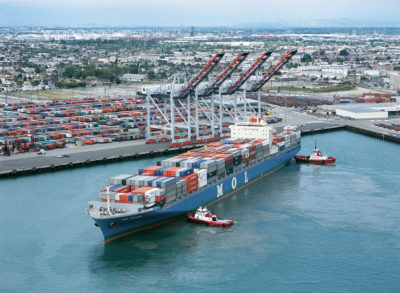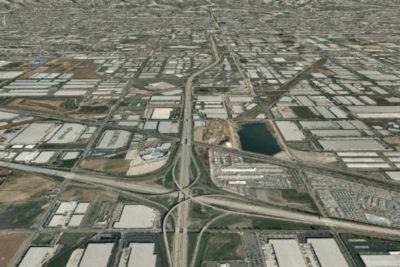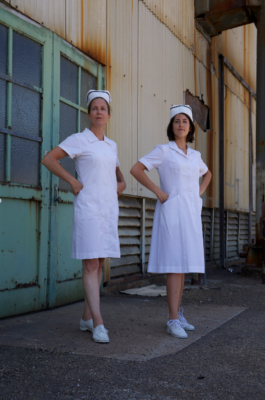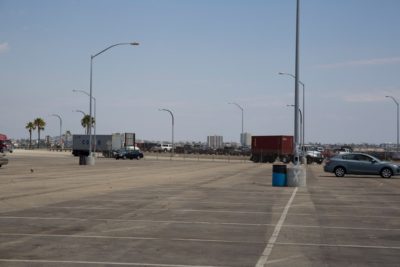Touring with Empire Logistics Group
31 July 2018 – Cathy Gudis
NCPH Board Member Posts, projects, advocacy, community history, sense of place, environment, NCPH, performance, heritage tourism

TraPac Container Terminal. Photo credit: Port of Los Angeles
Editor’s note: This post continues a series featuring contributions from members of the NCPH Board of Directors.
Lately I’ve been performing my public history. Several times this spring I’ve donned a business suit and silk blouse, straightened my blonde(ish) hair, and adopted the cheerful demeanor of a corporate publicist. Introducing myself as a Principal and CEO of the Empire Logistics Group (ELG), I speak on behalf of a faux trade association whose promotional efforts include sponsorship of the Bureau of Goods Transport, the chamber of commerce and clearinghouse for all things logistics. I tout the Bureau’s proudest achievement: the one and only heritage guide to industry sites in Southern California related to the global goods movement and the triplex marvel of containerization, intermodality, and information networks that enabled the logistics revolution.[i]
Now who wouldn’t be fascinated by a guided tour following a container?

Some sixty miles east of the congested coastal ports of Los Angeles/Long Beach are the “Inland Ports,” of Riverside-San Bernardino, where cargo arrives via truck and train processing and distribution. Photo credit: Penny Newman, “Inland Ports of Southern California—Warehouses, Distribution Centers, Intermodal Facilities: Impacts, Costs, and Trends,” (Center for Community Action and Environmental Justice, n.d.).
With a smile and a set of slides, I tour my seated audiences along the path of a container transported from ships at the Ports of Long Beach and Los Angeles (behold the Pacific!) onto a succession of freight trucks and trains through Southeast LA (the Diesel Death Zone!) to the Amazon (warehouses!).[ii] I boast the magnificent assets of a travel corridor rife with environmental toxicity and economic precarity, whose scenic wonders range from diesel-belching cargo ships in the Los Angeles Harbor, to the billion square feet of warehouses comprising magisterial Inland Ports where air is thick with a toxic stew that has won awards for San Bernardino and Riverside as the most ozone-polluted counties in America. (Way to go Inland Empire!) Most importantly (tone switching to boastful over-confidence), I assure tourists that the Empire Logistics Group will pave the path back to the middle class. Dismissing naysayers, I wave my hand to brush off claims that warehouse work is temporary, low waged, by demand, lacking in benefits, and conducted under poor conditions largely by immigrants and people of color.

Reenactment of Terminal Island Cannery Workers by Hannah Brown and Cathy Gudis. Photo credit: Cathy Gudis
Now who wouldn’t be proud of such a legacy and booster mission?
In case it’s not already apparent, let me state it forthrightly: the project aims to inject a hearty dose of irony into tropes of cultural heritage tourism, from the authority of the tour guide, to the authenticity of living history, to the promotional practices aimed to monetize heritage. In fact, my performance follows a script drawn directly from primary sources. Delivered with great sincerity, it also utilizes sites and stories represented in a tongue-in-cheek heritage guidebook that my friend and media studies scholar Ken Rogers and I began five years ago with UCR students, along with our colleague Juliann Allison, a political scientist long active in documenting impacts of global goods distribution on labor and the environment. We riff on the idea of heritage and how cultural patrimony is conferred on certain sites, and simulate tourist attractions where they don’t otherwise exist by staging photos of happy tourists (colleagues and their kids) interacting with living history reenactors (us and our students, with the help of Hollywood prop shop rentals). Humor, play, and the performative are the essence of the guide and tour, with mimicry a central practice. In fact, the project is fundamentally about investigating modes of public presentation, as a means to create a context for public dialogue.
Make no mistake, we are trying to ask serious questions: How can we reveal the forces and impact of the market, which is seemingly omniscient and omnipresent, yet is persistently hidden from view? Can we render visible and palpable the flow of goods, people, and capital as a means to reveal the political forces shaping our landscapes of distribution and consumption? Most importantly, we want to display the ecological injustices of distribution “efficiency.” Typically, those who live by the freeways and railways that make up the continental goods movement infrastructure are low-income, immigrant, and people of color; they experience higher incidences of cancers and air pollution-related illnesses, while they have the least say about what happens next door. We want to map this structural violence. Ultimately, we want to enable an affective and embodied experience of a geographical, economic, and social terrain that is difficult to understand without a guide to get you there. So, we’ve gone literal: we’ve created such a tour and guide.

Tour Stop: ILWU Parking Lot. Photo credit: Cathy Gudis
Can tourism be critical? Can it have an activist agenda? Might the performative enable empathy as well as comedy, sensitize us to different subject positions, or acknowledge political discordance in productive ways? As many of us embark on summer vacations and holiday tours, I hope you’ll join me in considering these questions, and in finding ways to add the politics of play to the portfolio of public history.
In the meantime, and on behalf of the Empire Logistics Group, thank you for touring!
~ Catherine Gudis is associate professor of history and director of the public history program at the University of California, Riverside, where she holds a Teresa and Byron Pollitt Endowed Term Chair for Interdisciplinary Research and Learning in the Humanities and Social Sciences. She has been core member of the Los Angeles Urban Rangers art collective since 2010, and has co-created Project 51’s Play the LA River. She serves on the NCPH Board of Directors.
[i] Logistics originated during World War II in reference to the supply chain management that would coordinate the complex delivery of rations, fuel, and weapons to soldiers on the frontline. Introduced into the private sector after the Vietnam War, logistics has become a staggeringly complex tactical integration of the industrial supply chain with every other aspect of the mode of production, from product design to consumer marketing.
[ii] “Diesel Death Zone” is so named for the rates of cancer, asthma, and childhood disease among residents along any one of the eight crisscrossing freeways in Southeast LA that takes our goods from ships at port along “Trade Corridors to America.”



